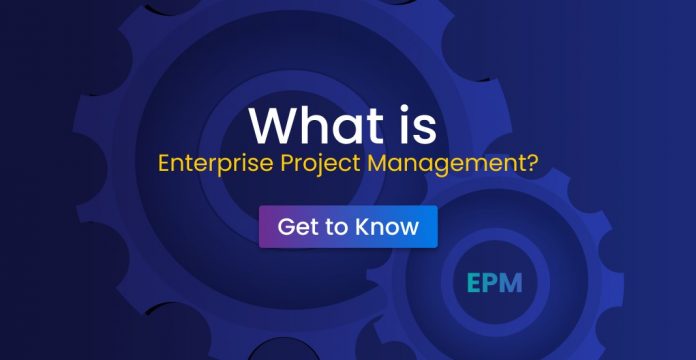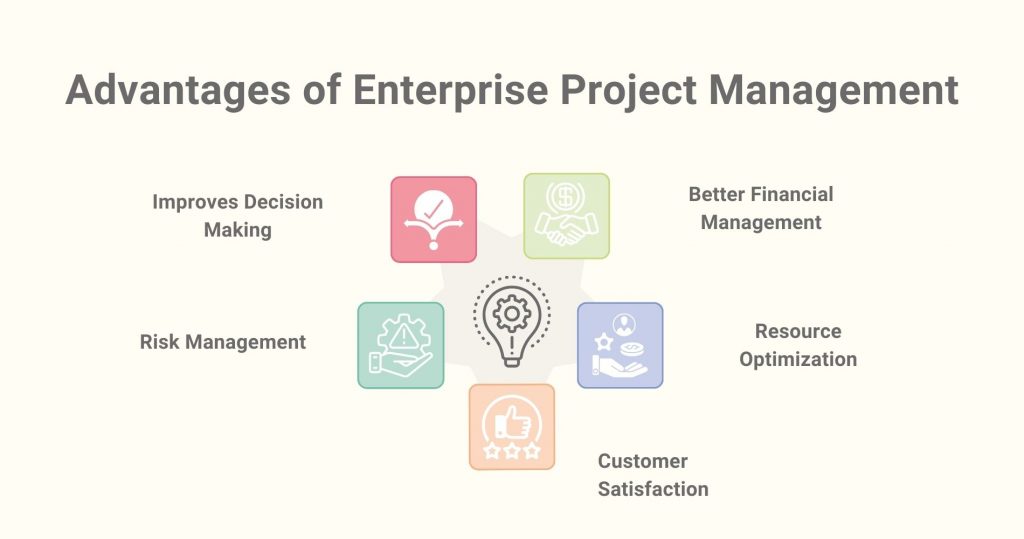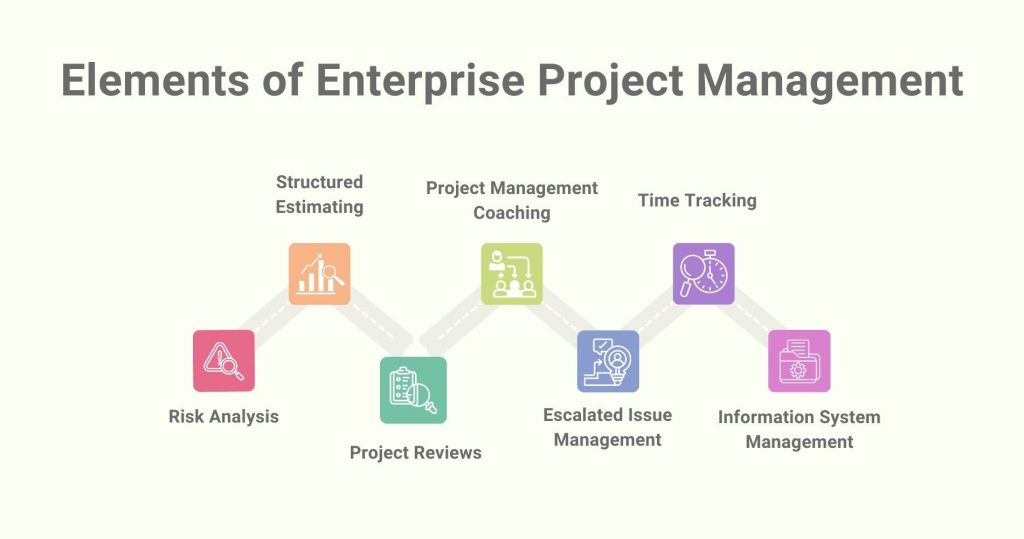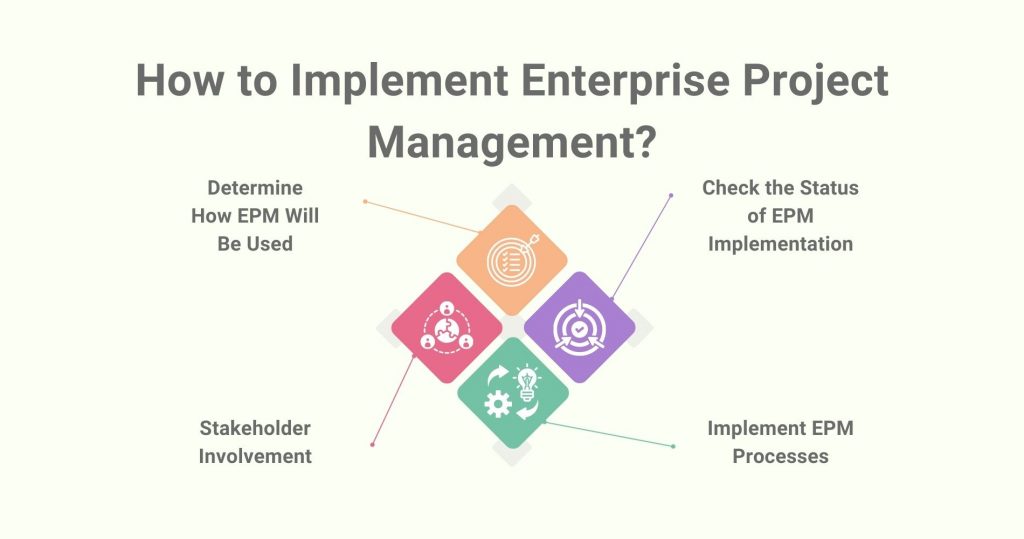
Within the corporate landscape, companies frequently undertake multiple expansive projects that have far-reaching implications across the organization. Successfully overseeing these initiatives necessitates applying enterprise project management (EPM), a structured methodology designed to deliver these company-wide projects efficiently.
For individuals aspiring to carve a niche in the field of project management, delving into the intricacies of EPM is not just beneficial but essential. This article aims to explain enterprise project management by detailing its components and offering step-by-step guidance on its implementation.
By comprehending the nuances of EPM, aspiring and seasoned project managers alike can enhance their skill sets and contribute significantly to the success of their respective organizations.
Table of Cotents
- What is Enterprise Project Management?
- Enterprise Project Management Benefits
- Key Elements of Enterprise Project Management
- Methodologies used in Enterprise Project Management
- Implementation of Enterprise Project Management
- Enterprise Project Management vs. Traditional Project Management
- Conclusion
What is Enterprise Project Management?
Enterprise Project Management (EPM) is a comprehensive approach to managing and overseeing projects within an organization. Unlike traditional project management, which focuses on individual projects, EPM takes a broader approach, considering many projects within the organization’s strategic goals.
It entails the systematic planning, implementation, monitoring, and control of large-scale projects to ensure they correspond with the company’s goals and contribute to its overall success.
EPM covers a wide range of topics, including resource allocation, risk management, budgeting, and collaboration, and it frequently involves the use of specialist software tools to simplify project-related tasks.
Businesses can optimize their project portfolios, improve team cooperation, and make informed decisions by implementing EPM principles, resulting in more efficient project delivery and enhanced organizational performance.
Benefits of Enterprise Project Management
Enterprise Project Management (EPM) offers several benefits to organizations aiming to manage their projects more effectively and strategically:
Improves Decision Making
One of EPM’s primary benefits is its ability to give real-time data and insights. Project managers and executives can gain access to precise, up-to-date data on project progress, resource usage, and budget status.
This data-driven strategy enables decision-makers to anticipate difficulties, detect potential bottlenecks, and make timely, educated decisions. Proactive decision-making based on trustworthy data results in more successful initiatives and better overall results.
Risk Management
Effective risk management is important for project success. EPM facilitates systematic risk identification, assessment, and mitigation strategies. Project teams can anticipate potential risks, create contingency plans, and respond promptly to unforeseen challenges.
By addressing risks proactively, organizations can minimize the impact of adverse events, ensuring that projects stay on schedule and within budget.
Better Financial Management
Financial management is a critical aspect of project success. EPM tools allow organizations to monitor project expenses, manage budgets effectively, and allocate funds based on project priorities.
By having a clear view of financial data, companies can prevent overspending, identify cost-saving opportunities, and ensure that projects are finished within the allocated budget constraints.
Resource Optimization
EPM enables organizations to optimize their resources effectively. Through advanced resource management tools, companies can match the right skills with the right tasks, preventing resource overloads or underutilization.
By balancing workloads and ensuring that resources are allocated efficiently, organizations can enhance productivity, reduce stress among team members, and maintain a sustainable pace of work.
Customer Satisfaction
Delivering projects efficiently and meeting or exceeding customer expectations increases customer satisfaction. Happy customers will likely return for future purchases and become enthusiastic clients for the company.
Positive customer experiences build the company’s reputation, enhance brand loyalty, and contribute to long-term relationships, which are invaluable in competitive markets.
Key Elements of Enterprise Project Management
The key elements of Enterprise Project Management (EPM) encompass a range of crucial components that collectively ensure the successful planning, execution, and oversight of projects within an organization.
These elements are essential for managing projects on a large scale and aligning them with the organization’s strategic goals. Here’s an overview of the key elements of EPM:
-
Risk Analysis
Risk analysis in enterprise project management involves identifying, assessing, and managing potential risks that could impact the project’s objectives. This process includes evaluating internal and external factors affecting project progress, budget, or quality.
By understanding these risks early on, project managers can develop strategies to mitigate or respond to them, ensuring the project stays on track and minimizing the chances of unexpected setbacks.
Go through top risk analysis methods and master the risk anlaysis process to safeguard the project from potential threats.
-
Structured Estimating
Project estimation, which involves estimating project costs, resources, and duration, is an essential part of project management. EPM establishes guidelines for structured estimating for project managers.
For example, the EPMO would define the typical project lifecycle and offer project managers examples of previous projects. The EPMO would also train PMOs on estimating techniques, including three-point estimation and the Delphi technique.
-
Project Reviews
Regular evaluations of ongoing projects, including project commitment, startup, progress, and close-out reviews, are conducted by the Enterprise Project Management Office (EPMO). These assessments focus on examining project standards, current status, and potential risks, aiming to identify any necessary updates for the risk mitigation plan.
One effective method employed during these reviews involves categorizing various project aspects, such as delivery, client management, team, and budget, with colors denoting their importance level (red/yellow/green). This color-coded system allows urgent issues to be promptly highlighted and discussed in management meetings, ensuring swift resolution.
-
Project Management Coaching
Managing projects can be a challenging role without proper training and resources. Enterprise Project Management Offices (EPMOs) support Project Management Offices (PMOs) by offering training programs that enable project managers to acquire the necessary technical and managerial skills.
This training is conducted by both in-house experts and external professionals. Moreover, EPMOs assign mentors to assist project managers throughout the project lifecycle, guiding the planning, execution, decision-making, and problem-solving stages.
-
Escalated Issue Management
In large projects, various issues and conflicts are inevitable. Escalated issue management refers to handling critical problems that cannot be resolved at lower levels of the project hierarchy.
Project managers escalate these issues to higher management or designated authorities for resolution. Timely and effective issue resolution prevents project delays, maintains team morale, and ensures project progress smoothly.
-
Time Tracking
Time tracking is a widely recognized approach for monitoring, strategizing, and overseeing projects, offering benefits at the project-specific and organizational levels. In many cases, EPM is entrusted with creating or deploying a time-tracking system aligned with the organization’s objectives.
EPMO could also analyze the data gathered from time-tracking software and share this valuable information with pertinent business units.
-
Information System Management
Information system management in EPM refers to effectively handling project-related data and technology tools. This includes selecting appropriate project management software, ensuring data security, integrating different software applications, and optimizing the use of technology to facilitate project communication, collaboration, and documentation.
Proper information system management enhances efficiency, reduces manual errors, and promotes seamless project workflow.
What are the Methodologies Used in Enterprise Project Management?
In Enterprise Project Management (EPM), various methodologies are employed to plan, execute, and control projects effectively within large organizations. These methodologies provide structured approaches to project management, ensuring consistency, efficiency, and alignment with business goals. Common methodologies used in EPM include
- Agile: Agile is a flexible approach emphasizing collaboration, customer feedback, and adaptability. It promotes incremental development, allowing teams to respond to changing requirements efficiently.
- Six Sigma Methodology: Six Sigma methodology is a data-driven methodology focused on process improvement and defect minimization, ensuring high-quality project outcomes.
- Waterfall Methodology: Waterfall Methodology is a linear project management approach progressing sequentially through phases, suitable for well-defined projects with clear requirements.
- Critical Chain: Focuses on resource optimization and managing project constraints by identifying the critical chain of tasks, enabling efficient resource allocation and streamlined project schedules.
- Critical Path Method (CPM): A project scheduling technique identifying the longest task sequence, aiding project planning and resource allocation by understanding task dependencies.
- eXtreme Programming (XP): An Agile methodology emphasizing customer satisfaction, continuous feedback, and rapid adaptation. Practices include pair programming and continuous integration.
- Kanban: An Agile method focusing on visualizing work, limiting work in progress, and optimizing flow, enhancing task management and workflow efficiency.
- Lean: A methodology eliminating waste and optimizing processes, emphasizing continuous improvement and customer value delivery.
- PERT (Program Evaluation and Review Technique): A project management technique using probabilistic methods to estimate task duration, accounting for uncertainties and enhancing project timelines.
- PRINCE2 (Projects IN Controlled Environments): A process-driven project management framework emphasizing structured guidelines for efficient project governance.
- Scrum: An Agile framework dividing work into sprints, emphasizing collaboration and transparency, suitable for iterative development.
- Scrumban: Combines Scrum and Kanban elements, balancing planned work with continuous flow, allowing teams to adapt to changing priorities.
Implementation of Enterprise Project Management
If your teams struggle to monitor ongoing projects and track progress effectively, considering EPM as a solution is a viable option. The company’s structure needs to be modified to enable the EPM system, which may result in organizational modifications.
Before transitioning, the management team should assess the existing company structure, identify operational obstacles, and evaluate the long-term viability of the strategy. Once the organization is prepared for EPM implementation, follow these steps to initiate the process.
-
Determine How EPM Will Be Used
Before implementing EPM, it’s crucial to define the scope and purpose of its usage within the organization. Determine the specific goals EPM aims to achieve, whether it’s optimizing project portfolios, improving resource management, enhancing collaboration, or aligning projects with strategic objectives.
Clear objectives guide the implementation process and ensure that EPM is tailored to meet the organization’s unique needs.
-
Stakeholder Involvement
Involving stakeholders at various company levels is vital for the successful implementation of EPM. Engage key stakeholders, such as executives, project managers, team members, and clients, in the planning and decision-making processes.
Their input and feedback are valuable for aligning EPM with organizational goals, addressing concerns, and ensuring that the implemented processes resonate with the entire team.
-
Implement EPM Processes
Implementing EPM involves establishing standardized processes and methodologies across the organization. Develop clear workflows for project initiation, planning, execution, monitoring, and closure.
Integrate chosen project management methodologies, tools, and best practices into these processes. Train the teams to familiarize them with the new methods and tools. Consistent implementation of these processes ensures uniformity in project management practices, improving efficiency and project outcomes.
-
Check the Status of EPM Implementation
Regularly monitor and evaluate the progress of EPM implementation. Assess whether the established processes are being followed and whether they align with the organization’s objectives. Track key performance indicators (KPIs) related to project success, team productivity, and client satisfaction.
Conduct periodic reviews and gather feedback from stakeholders to recognize any challenges or areas for improvement. Monitoring the status of EPM implementation allows the organization to make necessary adjustments, address issues promptly, and ensure that the objectives are being met effectively.
Enterprise Project Management vs. Traditional Project Management
Enterprise Project Management (EPM) and Traditional Project Management are two distinct approaches to managing projects within an organization. Enterprise project management oversees the whole project portfolio of the organization. While project planning, management, and implementation are important, EPM provides a larger strategic view of business goals.
Traditional project management is concerned with completing a single project or endeavor. The project manager organizes, manages, and implements the project while keeping the project’s goals in mind – building a bridge, developing software to perform a specific set of functions, etc.
| Aspect | Enterprise Project Management (EPM) | Traditional Project Management |
| Scope | Manages multiple projects across the organization, aligning them with strategic goals and objectives | Focuses on managing individual projects independently |
| Scale | Suitable for large enterprises with extensive project portfolios | Applicable to small to medium-sized projects or specific tasks |
| Integration | Integrates project management processes with overall organizational processes and systems | Operates as a standalone project management approach |
| Visibility | Provides real-time visibility into multiple projects, allowing comprehensive analysis and decision-making | Offers limited visibility and coordination between projects |
| Resource Management | Optimizes resource allocation across various projects, ensuring efficient use of personnel and assets | Resources are managed within the scope of individual projects |
| Risk Management | Offers systematic risk analysis and mitigation strategies at the organizational level, addressing risks across projects | Focuses on risk management within the confines of individual projects |
| Decision-Making | Supports data-driven decision-making by providing consolidated project data for strategic planning | Decisions are primarily based on project-specific data |
| Flexibility | Adapts to changing business requirements and accommodates shifts in project priorities seamlessly | Less flexible, making it challenging to accommodate sudden changes effectively |
| Standardization | Promotes standardization of processes and best practices across all projects, ensuring consistency | Standardization may vary between projects and project managers |
| Collaboration | Encourages collaboration and communication across teams, departments, and stakeholders | Collaboration is limited to the project team and immediate stakeholders |
| Performance Evaluation | Enables evaluation of overall project portfolio performance, allowing organizations to refine strategies | Evaluation is project-specific, with limited impact on overall organizational strategy |
| Long-term Strategy | Aligns projects with long-term organizational goals, fostering sustainable growth and competitiveness | Focuses on achieving short-term project objectives without significant impact on long-term strategy |
Conclusion
Enterprise Project Management (EPM) is a powerful strategic approach that takes project management to a higher organizational level. It goes beyond traditional project management methods in that it integrates many projects, aligns them with overarching company goals, and ensures optimal resource usage.
EPM provides real-time visibility, encourages collaboration, and promotes data-driven decision-making, allowing firms to adjust quickly in today’s volatile business environment. Businesses can achieve increased efficiency, higher project success rates, and competitive advantage by implementing EPM, making it a vital tool for directing complex projects and entire companies toward long-term growth and success.
Interested in mastering the art of Enterprise Project Management (EPM)? Explore our Project Management certification courses at Invensis Learning, which are designed to equip you with the skills to manage complex projects. Enroll now and elevate your project management expertise with us!

















